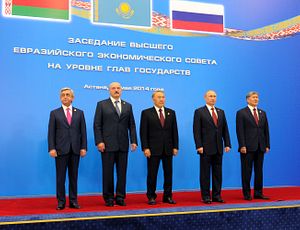2015 was meant to be the year that the Eurasian regional integration project took off. The launch of the Eurasian Economic Union (EEU) on January 1 marked a qualitative change in the scope and ambition of post-Soviet economic integration. The EEU treaty, signed amid much fanfare in May 2014, went significantly beyond a free trade zone. It bound the signatory states into an ambitious institutional framework and established a complex system of interactions between national and supranational governance structures. Crucially, the treaty also added a clear geopolitical dimension to the integration project, by establishing the EEU as an international organization and an object of international law. As a result, whether or not all the signatories admitted it, the organization could never simply be solely about economic cooperation.
The EEU’s proponents must have hoped that the first year would provide an opportunity for acclimatization to the new institutional architecture and consolidation of its governance framework. Instead, events of the past year have not only underscored pre-existing contradictions, but also exposed the Eurasian Economic Union to new pressures.

































